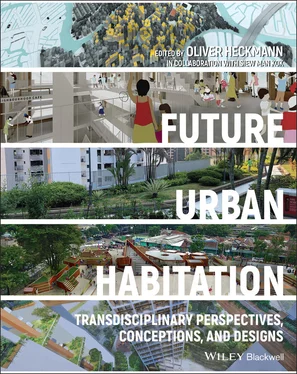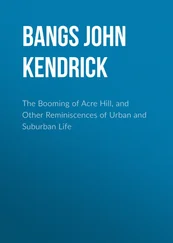Sebastià RiutortIERMB – Barcelona Institute of Regional and Metropolitan Studies Barcelona Spain
Siew Man KokMKPL Architects Singapore
Daliana SuryawinataSHAU Architects Bandung, Indonesia Rotterdam, Netherlands
Cherylanne TanAlexandra Hospital National University Health System Singapore
Kimberly TeoAlexandra Hospital National University Health System Singapore
To KienSocial Urban Research Groupe Singapore
Lluís TorrensBarcelona City Council Area of Social Rights Barcelona Spain
Bernd VlayStudioVlayStreeruwitz Vienna Austria
Neil WalmsleyArup, Singapore
Sharon WohlDepartment of Architecture Iowa State University Ames USA
Saffron WoodcraftInstitute for Global Prosperity at University College London London UK
Oliver Heckmann
Urban Housing Lab, Berlin, Germany
‘Future Urban Habitation’ illustrates how transdisciplinary design and research practises, how multiple expertise from design, engineering, policy, and research fields could engage in discussions between contributors, whose collaboration would be essential to synthesize forward‐looking, sustainable perspectives for the urban habitats of the future. Given pressing challenges of ongoing urban growth, societal segregation, and inequality, dynamically changing societies with shifting demographics and the consequences of climate change, the responses will necessarily impact housing typologies and their hard‐, org‐, and software, concepts for urban communities, discussions on the social, economic, and environmental sustainability of habitats, and the crucial questions about control and ownership.
Since these complex aspects can only be responded to by multiple domains and their collaboration, the book combines different expertise: practitioners and researchers from architectural and social design fields, engineers, administrators, experts on housing‐, social‐ and health‐service policies, and field‐working anthropologists and sociologists. Four intersecting frameworks are covered as transformative agendas: Inclusive Urbanism, High‐Dense Typologies for Building Communities, Adaptive and Responsive Habitation, and New Tools, New Approaches. The authors discuss how urban territories could empower affordable, inclusive collective living. They propose, how liveable urban neighbourhoods could engender a sense of belonging in complex dynamic urban communities and pay attention to their diversity. They discuss how significant societal and demographic shifts, pressing care‐gaps, and diversifying forms of sharing habitats could be accommodated and responded to. They argue how pressing socio‐economic and environmental challenges influence design‐thinking and push to develop and employ new capabilities and practises like people‐centric social design.
Originating from the research of the Urban Housing Lab at Singapore University of Technology and Design, the publication builds up in parts on a symposium conducted at the National Design Centre Singapore. Singapore, as an exemplary place for its successful public housing, is in a few chapters thus also taken as a common platform to correlate contributions from different domains – design strategies for high‐rise habitats, health policies, social design initiatives, public housing policies, and related research from different domains. Together with transdisciplinary works and researches on other locations covered in the book, like for cities and communes in Indonesia, for Vienna, Barcelona, London, Detroit, or Winnipeg, such places are considered to be laboratories for future urban habitation. Taking the book as a joint reflection beyond professional silos about a future of urban living is seen as an opportunity to envision both social and architectural strategies for sustainable and liveable urban habitats that could illustrate design objectives applicable for different scales and situations.
While housing is a core focus of this book, habitation is chosen as a more appropriate term for various reasons. It not only transcends the often monofunctional focus on housing and with it the different socio‐spatial demarcations of the apartment, the house, the neighbourhood, and the city, but it also encompasses the socio‐economic practises and networks emerging across these domains. Also, in its biological definition habitation entails the complex dimensions of coexistence with others in shared territories. Lefebvre (1968/1995) took habitation not as a mere commodity, but as activity and with that as a potential agency. To inhabit means to ‘take part in a social life’ of a community, ‘giving the right to inhabit’ also with the ‘plasticity’ of dwellings that enabled groups and individuals to model them according to their conditions.
Habitation was always instrumental for urban development as such, in periods of historical, economical, and societal transitions. Examples are the immense housing constructions for radically growing populations due to industrialization or rural exodus, as two of the decisive push and pull factors for urban growth, or the rebuilding of cities after destructions of war, to accommodate pressing needs for affordable housing or to revive economies and secure employment. Global shifts in industrial production affected not only the social fabric of entire cities but also released vast central areas for urban revitalization, offering opportunities to rethink needs and opportunities for urban habitation as such. Urban habitats have also always been a field of debates and have been impacted by them, like by the questioning of modernist design paradigms, the iterations on new building types, the criticism of urban sprawls, the demands emerging with the ‘second demographic shifts’ (Lesthaeghe 2010) or activist campaigns regarding who is owning the city, to mention a few.
The question of ownership and who has control and agencies on urban habitation has always been crucial. While mass social housing has been justifiably criticized for its normative, social engineering paradigms, it was able to engender affordable housing for vast sections of urban populations. The ongoing shifts away from it towards profit‐driven housing developers and the commodification of housing again influence the societal balances in cities in their totality, causing inequalities and segregations that impact the very opportunities to equally participate, contribute, and benefit from the resources that cities offer.
An often referred to point of reference for discussions on urban habitation is the UN's prediction that by 2050 68% of the world population is going to live in urban areas, from currently 50% on average (UN Department of Economic and Social Affairs Population Division 2019). While the respective migrations will most impactfully affect the developing regions in Asia and Africa, urban populations as well increase in European and North American cities, if so modestly. Here, the respective push and pull factors like the shifts in global industrial production influence cities differently, can either lead to significant depopulation in cities like Detroit or to the release of vast central areas for urban revitalization projects in Northern Europe. New developments here face, to a certain extent, comparable challenges as those in megacities like in Asia – similarly requesting socio‐spatial strategies to engender inclusivity and a sense of belonging. Also, with the impacts of social diversification and segregation and the global migration, it is – beyond the crucial provision of liveable, affordable shelter – in any context crucial to cater to the integrative potentials shared habitats can have.
Читать дальше












